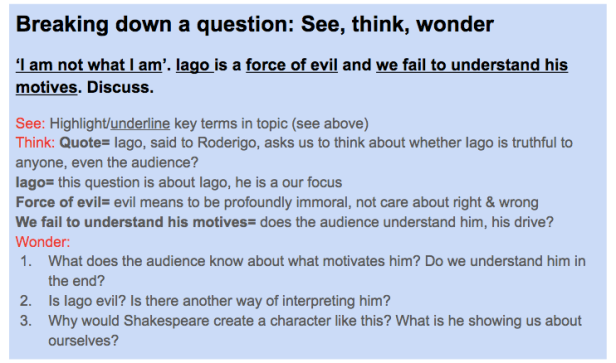I have taught senior years VCE English in Victoria, Australia for a while now. Every year after the end-of-year external examinations, the assessor’s report always gives this same advice: students need to answer the question in front of them.
Time and time again, students jump to conclusions, don’t think deeply about the meaning of a word or how it could be interpreted. Under the pressure of exams, they see how this question is similar to another one they’ve written and then just plug in a response. Unfortunately, however, this often doesn’t work. Students fail to take note of the subtlety of the topic they are trying to answer.
As I teach only senior years English classes, I’ve had a lot of time to think about this and to consider how I can get students to think critically for themselves (which is what they will inevitably have to do in an exam situation). Students need some kind of framework for thinking that can be used for any topic. The framework needs to prompt divergent thinking, which, unfortunately, some routines fail to do.
For instance, in my class we’ve currently been studying Shakespeare’s ‘Othello’ and now we’re planning out essay responses. Here are a few example topics I gave my students:
Shakespeare suggests that at times, judgement may be clouded by a sense of duty. Discuss.
Discuss the role of jealousy in ‘Othello’.
Students came to me wanting an easy way to formulate arguments to these questions. They liked to think that for any essay question you should be able to either have one agree and two disagree statements, or vice versa. Unfortunately, however, for questions like the second, there’s nothing to disagree with- you need to come to that very general question with an already formulated idea of what the play shows us about jealousy -otherwise students will often end up writing a piece that just explains three events which involve jealousy. Some topics don’t present a clear line of argument that needs to be both agreed and disagreed with.
So, here’s what I’ve come to use this year, with various slight adjustments over the years. This is a powerpoint slide of the process that I show my students when we first look at a question:

Our school has worked for a number of years with Ron Richhart, a researcher at the Harvard Graduate School of Education, who has mapped out what thinking looks like, what cultures of thinking exist in classrooms and what thinking routines help to build student thinking (note: this is a very general overview, please see links at the bottom of this post for more resources). There’s lots of routines that can be used everyday in classrooms and that will work across subject areas. To help students break down essay topics, I wanted to use the ‘See, Think, Wonder’ (STW) routine (as explained above). The idea being that students have to slow down their thinking and can’t just look at the question and formulate agree/disagree statements in response. Below is my model STW on the same question:

The reason why I like using this is because it ascends in terms of difficulty. Students have to first pick out the important words, work out what they mean or point us towards and then figure out the underlying questions. Working out these questions is the HARDEST part, but also the most VITAL in order to ensure that students are actually thinking about the question. I tell my students that one of their questions will always be something like ‘Why would Shakespeare do this?’ This means that they have to think about authorial intent purposefully. Once they have the Wonder Questions, students can then use these to base their arguments on.
The aim for me is that students will be able to capably do this without me. So we’ll keep repeating this process in class using a gradual release of responsibility model. Below are some examples of student work using this model- they had 25 minutes to collaboratively plan out an essay topic on the whiteboard walls and then had to present it to the class. They were able to do this quite quickly, but still need some more work on linking their Wonder questions to their arguments and ensuring that they have a clear sequence of argument over their topic sentences. After all the plans were finished, we ended up discussing these issues and looking for pitfalls in the plans of each group, eventually ending by voting for the best plan.


If you have any other ideas as to how to improve this or can suggest other ways you get students to think about breaking down questions, let me know!
Ron Richhart: http://www.ronritchhart.com/ronritchhart.com/Welcome.html
Visible Thinking Harvard’s Project Zero: http://www.visiblethinkingpz.org/VisibleThinking_html_files/VisibleThinking1.html
See, Think, Wonder Thinking Routine Explained: http://www.visiblethinkingpz.org/VisibleThinking_html_files/03_ThinkingRoutines/03c_Core_routines/SeeThinkWonder/SeeThinkWonder_Routine.html

A clearly explained process. Although I use a similar process, the simplicity of see-think-wonder will make teaching response writing a little easier (hopefully)
Glad to hear it. Please let me know how you go!